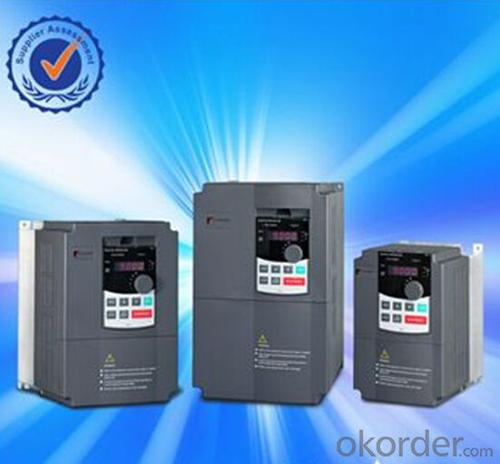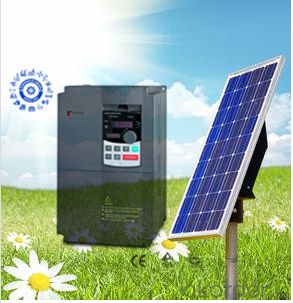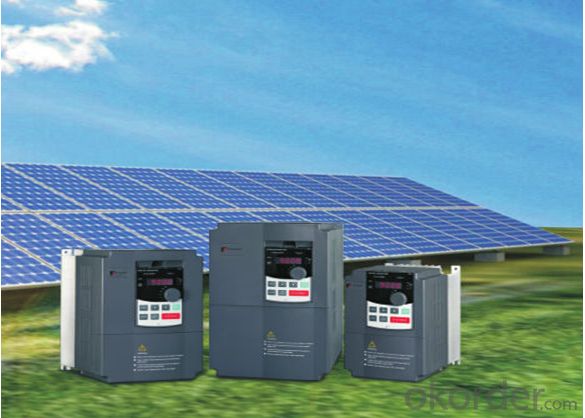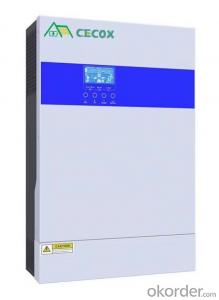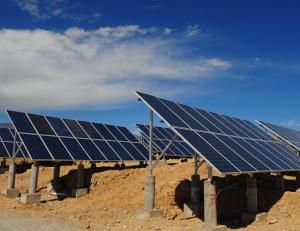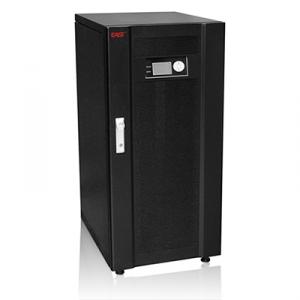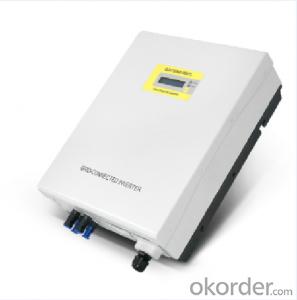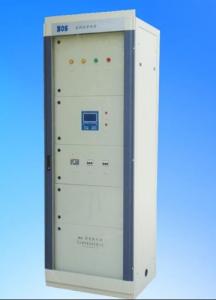Solar Inverter Adelaide - Off Grid MPPT Solar Inverter, Solar Pump Inverter 380V 2.2KW 4KW 5.5KW
- Loading Port:
- Shanghai
- Payment Terms:
- TT or LC
- Min Order Qty:
- 150000 watt
- Supply Capability:
- 3000000 watt/month
OKorder Service Pledge
OKorder Financial Service
You Might Also Like
1. Structure of Off Grid MPPT Solar Inverter, Solar Pump Inverter 380v 2.2kw 4kw 5.5kw Description
A solar inverter, or PV inverter, or Solar converter, converts the variable direct current (DC) output of a photovoltaic (PV) solar panel into a
utility frequency alternating current (AC) that can be fed into a commercial electrical grid or used by a local, off-grid electrical network. It is
a critical BOS–component in a photovoltaic system, allowing the use of ordinary AC-powered equipment. Solar inverters have special
functions adapted for use with photovoltaic arrays, including maximum power point tracking and anti-islanding protection.
2. Main Features of the Off Grid MPPT Solar Inverter, Solar Pump Inverter 380v 2.2kw 4kw 5.5kw
﹒ Supports AC&DC input:
DC solar panel input. And If no good sunshine, can use grid AC regular input work the pumps.
﹒Dry protection :
If no water in the ground, the water pump will stop working automaticly and when the water comes, starts to working automaticly.
﹒Automatic working:
When the sunshine not good then pumps slow down automatically and when sun become good then go on working.
﹒Save cost/directly connect solar panel:
Solar panle connects solar inverter directly and to the pump. Also can control the water level in the tank. No enough water in the tank
working fast, enough water will stop working automaticly. (how many water you need, you can set the parameters)
﹒Speed & frequency control, No need battery:
3. Off Grid MPPT Solar Inverter, Solar Pump Inverter 380v 2.2kw 4kw 5.5kw Images

4. Off Grid MPPT Solar Inverter, Solar Pump Inverter 380v 2.2kw 4kw 5.5kw Specification
Inverter Model | Input voltage | Rated output power (kW) | Rated output current (A) |
PI9100-S 0R4G1 | Single phase AC 220V ± 10%;
DC 220-380V | 0.4 | 2.5 |
PI9100-S 0R7G1 | 0.75 | 4 | |
PI9100-S 1R5G1 | 1.5 | 7 | |
PI9100-S 2R2G1 | 2.2 | 10 | |
PI9100-S 004G1 | 4.0 | 16 | |
PI9200-S 5R5G1 | 5.5 | 25 | |
PI9100-S 0R4G2 | 3 phase AC 220V ± 10%;
DC 220-380V | 0.4 | 2.5 |
PI9100-S 0R7G2 | 0.75 | 4 | |
PI9100-S 1R5G2 | 1.5 | 7 | |
PI9100-S 2R2G2 | 2.2 | 10 | |
PI9100-S 004G2 | 4.0 | 16 | |
PI9200-S 5R5G2 | 5.5 | 25 | |
PI9200-S 7R5G2 | 7.5 | 32 | |
PI9200-S 011G2 | 11 | 45 | |
PI9200-S 015G2 | 15.0 | 60 | |
PI9100-S 0R7G3 | 3 phase AC 380V ± 10%;
DC 350-750V | 0.75 | 2.5 |
PI9100-S 1R5G3 | 1.5 | 3.8 | |
PI9100-S 2R2G3 | 2.2 | 5.1 | |
PI9100-S 004G3 | 4.0 | 9 | |
PI9100-S 5R5G3 | 5.5 | 13 | |
PI9100-S 7R5G3 | 7.5 | 17 | |
PI9230-S 011G3 | 11 | 25 | |
PI9230-S 015G3 | 15 | 32 |
5. FAQ of Off Grid MPPT Solar Inverter, Solar Pump Inverter 380v 2.2kw 4kw 5.5kw
Q1. What is the difference between inverter and solar inverter?
A1. Inverter only has AC inpput, but solar inverter both connect to AC input and solar panel, it saves more power.
Q2. What is the difference between MPPT&PWM?
A2. MPPT has higher efficiency, it can track the max power point and won't waste energy.
Q3. What is the waranty of product?
A3. 12 months.
- Q: How does a solar inverter handle variations in temperature?
- A solar inverter is designed to handle variations in temperature by incorporating temperature sensors and thermal management systems. These sensors monitor the temperature of the inverter and its components, allowing it to adjust its operations accordingly. The inverter's thermal management system helps dissipate excess heat and prevent overheating, ensuring optimal performance and longevity. Additionally, advanced inverters may have temperature compensation algorithms that adjust the voltage and power output to compensate for the temperature changes, maximizing energy production.
- Q: What is the role of a solar inverter in a solar-powered ventilation system?
- The role of a solar inverter in a solar-powered ventilation system is to convert the direct current (DC) electricity generated by the solar panels into alternating current (AC) electricity, which is the type of electricity used in most household appliances. This conversion allows the ventilation system to effectively utilize the solar energy and power the fans, motors, or other components of the system.
- Q: How does a solar inverter work?
- A solar inverter works by converting the direct current (DC) electricity produced by solar panels into alternating current (AC) electricity that can be used to power household appliances and be connected to the electric grid. It also ensures that the solar panels operate at their maximum efficiency by tracking the maximum power point and optimizing the power output.
- Q: How does a solar inverter handle voltage and frequency variations caused by sudden load changes?
- Efficient and reliable, a solar inverter is specifically engineered to manage fluctuations in voltage and frequency resulting from sudden changes in load. When such changes occur, the solar inverter effectively employs a variety of control mechanisms to regulate and stabilize the output voltage and frequency. To begin with, the inverter continuously monitors the incoming solar power, keeping a close eye on the voltage and frequency. If any variations arise due to sudden load changes, the inverter promptly adjusts its internal control systems to compensate. Utilizing advanced power electronics and control algorithms, the inverter ensures that the voltage and frequency remain within the desired range. In order to handle voltage fluctuations caused by sudden load changes, the solar inverter utilizes a technique known as voltage regulation. It automatically adjusts the output voltage, either raising or lowering it as necessary. This guarantees that the inverter delivers a steady and consistent voltage supply to the load, effectively preventing any harm or malfunction. Similarly, to address frequency variations brought on by sudden load changes, the solar inverter employs a technique called frequency regulation. It adjusts the output frequency to match the grid frequency or meet specific frequency requirements. By maintaining the desired frequency, the inverter ensures compatibility and synchronization with the grid or other connected devices. In addition to voltage and frequency regulation, solar inverters also incorporate protective features to handle sudden load changes. They are equipped with built-in overload protection mechanisms capable of detecting excessive loads and preventing damage to both the inverter and the connected devices. These protective features may include safeguards such as overcurrent protection, short-circuit protection, and temperature monitoring. In summary, a solar inverter is purposefully designed to effectively manage voltage and frequency variations arising from sudden load changes. Through its voltage and frequency regulation capabilities, as well as its protective features, the inverter ensures stable and reliable operation. This enables the inverter to adapt efficiently to changing load conditions while safeguarding the integrity of the power supply.
- Q: Can a solar inverter be used in areas with high dust and dirt accumulation?
- Yes, it is possible to use a solar inverter in areas where there is a high accumulation of dust and dirt. However, it is important to take specific precautions and maintenance measures to guarantee its proper operation. Over time, dust and dirt can build up on the surface of the solar panels, causing a decrease in their efficiency. This can also have an impact on the performance of the solar inverter, as it relies on the energy produced by the solar panels. To minimize the impact of dust and dirt, it is essential to regularly clean the solar panels. This can be accomplished by using a gentle brush or sponge along with a mild detergent mixed with water. It is important to avoid using abrasive materials or applying excessive water pressure, as this may cause damage to the panels. Additionally, installing the solar panels at an angle and orienting them towards the sun can aid in reducing the accumulation of dust and dirt. Furthermore, some solar inverters are designed with built-in protection against dust and dirt. These inverters typically have IP65 or higher ratings, which indicates that they are dust-resistant and capable of withstanding water jets. Opting for such inverters can provide an extra layer of protection against the negative effects of dust and dirt accumulation. Overall, while it is possible to use a solar inverter in areas with high dust and dirt accumulation, regular maintenance and proper cleaning of the solar panels are crucial to ensure optimal performance and longevity of the system.
- Q: What is the maximum AC output power of a solar inverter?
- The maximum AC output power of a solar inverter is determined by its capacity and specifications, but it typically ranges from a few hundred watts to several kilowatts.
- Q: What is the maximum number of parallel inverters that can be installed in a solar system?
- The maximum number of parallel inverters that can be installed in a solar system depends on the specific requirements of the system and the available infrastructure. There is no fixed limit, as it varies based on factors such as the size of the system, the capacity of the inverters, the electrical load, and the design limitations. It is best to consult with a solar system designer or engineer to determine the optimal number of parallel inverters for a particular solar installation.
- Q: Can a solar inverter be used in regions with high humidity or moisture levels?
- Yes, solar inverters can be used in regions with high humidity or moisture levels. However, it is important to ensure that the inverter is designed and rated for such conditions. The inverter should have adequate protection against moisture, such as being IP65 rated or higher, to prevent any damage or malfunctions due to humidity or moisture.
- Q: Can a solar inverter be used with a three-phase electrical system?
- Yes, a solar inverter can be used with a three-phase electrical system. In fact, many solar inverters are specifically designed to work with three-phase systems. They convert the direct current (DC) generated by the solar panels into alternating current (AC) that can be used to power three-phase electrical loads.
- Q: How is the size of a solar inverter determined?
- The size of a solar inverter is determined based on the maximum power output of the solar panels connected to it. It should match or exceed the total capacity of the solar panels to ensure optimal performance and avoid any power limitations.
Send your message to us
Solar Inverter Adelaide - Off Grid MPPT Solar Inverter, Solar Pump Inverter 380V 2.2KW 4KW 5.5KW
- Loading Port:
- Shanghai
- Payment Terms:
- TT or LC
- Min Order Qty:
- 150000 watt
- Supply Capability:
- 3000000 watt/month
OKorder Service Pledge
OKorder Financial Service
Similar products
Hot products
Hot Searches
Related keywords



